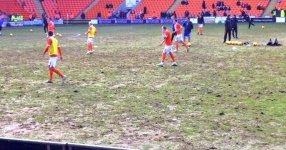You are correct with your statement: micro-climate but overall, the Fylde coast was labelled a “sunshine belt” by the Victorians. “Fresh air and fun.”
The very fact that the area is low lying is not conducive to the moist air being forced upward, cooling, condensing and forming rain drops. However, this can be counterbalanced by the prevailing winds from the oceanic West: first dibs on rain for us! (PS: global warming raises precipitation levels.)
Muddy soil? If you’ve lived on both the North and South Fylde coast, it’s clay based in the North but sand in the South. Both do drain but the air gaps in clay are fewer and much slower to pass water. I’d put the stadium pretty much on the boundary.
The pitch is designed as a balance of clay and sand. So, expect it to look a bit muddy in wet periods but ‘bouncy’ when dry.
We appear to water the pitch every match day (probably when no-ones there too) and that includes when the juniors are about to play. Put the muddy patches down to wear and tear. Remember the wear and tear on the touchlines?

